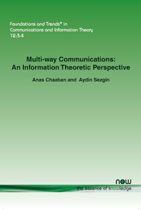Multi-way Communications: An Information Theoretic Perspective
By Anas Chaaban, Ruhr-University Bochum, Germany, anas.chaaban@rub.de | Aydin Sezgin, Ruhr-University Bochum, Germany, aydin.sezgin@rub.de
Abstract
Multi-way communication is a means to significantly improve the spectral efficiency of wireless networks. For instance, in a bi-directional (or two-way) communication channel, two users can simultaneously use the transmission medium to exchange information, thus achieving up to twice the rate that would be achieved had each user transmitted separately. Multi-way communications provides an overview on the developments in this research area since it has been initiated by Shannon. The basic two-way communication channel is considered first, followed by the two-way relay channel obtained by the deployment of an additional cooperative relay node to improve the overall communication performance. This basic setup is then extended to multi-user systems. For all these setups, fundamental limits on the achievable rates are reviewed, thereby making use of a linear high-SNR deterministic channel model to provide valuable insights which are helpful when discussing the coding schemes for Gaussian channel models in detail. Several tools and communication strategies are used in the process, including (but not limited to) computation, signal-space alignment, and nested-lattice codes. Finally, extensions of multi-way communication channels to multiple antenna settings are discussed.
Multi-way Communications
Multi-way communication is a means to significantly improve the spectral efficiency of wireless networks. This monograph provides an overview of the developments in this research area since it was initiated by Claude Shannon. The basic two-way communication channel is considered first, followed by the two-way relay channel obtained by the deployment of an additional cooperative relay node to improve the overall communication performance. This basic setup is then extended to multi-user systems. For all these setups, fundamental limits on the achievable rates are reviewed, making use of a linear high-SNR deterministic channel model to provide valuable insights that are helpful when discussing of the coding schemes for Gaussian channel models in detail. Several tools and communication strategies are used in the process, including computation, signal-space alignment, and nested lattice codes. Finally, extensions of multi-way communication channels to multiple antenna settings are discussed. This monograph provides a starting point for any researcher or student in understanding this important topic central to wireless communication systems.
